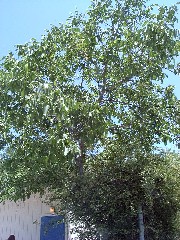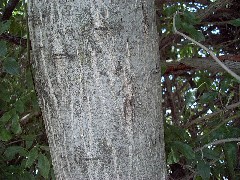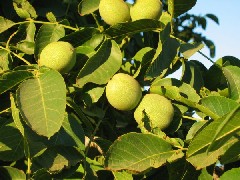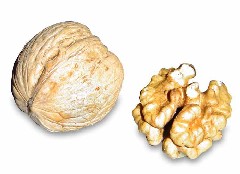Plant Common Name
Scientific name:Juglans californica S.Wats.(2)Family:Juglandaceae (4)
Podcast Script
 Walnut tree-full |
 Walnut Bark |
 Rob-Potash&Phosphate Institute(5) Walnut leaves |
 de:Benutzer:Horst Frank(6) Walnut fruit |
Classification:
-Angiosperm, Dicot, deciduousSize:-
-for the most part, the walnut's size is about 20-60meters tall, a trunk size of 5m or more in diameter. Some of the larger species include the black walnut or Persian walnut (1)Identifying Features:
Its order Juglandeas is classified by aromatic leaves, which are estipulate, alternate, and pinnately compound. Walnut is the largest species of the order, growing up with limbs long as 30 ft. from the branch.Location/Habitat:
The walnut orginally came from the Italy/Greece region and later migrated through Europe and Asia. The best known type of walnuts is the Persian Walnut, although the more popular one in Northern America would be the black walnut. However, in North America, the black walnut's kernel is too small to be considered for retail consumption.the walnut plant is usually grown in temperate habitats. The shootsare formed furing late April/early May(2).
Flower/Fruit/Reproduction:
Flowers and leaf usually develop in April, but there are earlier and later variations. The fruit has a green/fleshy husk or "epicarp" in which the former bursts, and inside there is a two piece woody "endocarp". The seed is developed in the brown testa and a creamy inner coat. The seed can be found in the center.-To get access to the actual nut during harvest season, the walnut trees need to be shaken in order for the walnuts to fall to the ground and be collected. Later, the walnut is then shelled and seperated according to sizes waiting to be packed and shipped (2)
Water/Sun Requirements:
-for the most part, the walnut plant needs moderate watering and has some draought resistance.-The soil need is moderate(2).
-the plant likes alot of sun. (1)
Special Adaptations:
-While young plants are suspetible to spring frosts, the Walnut plant increases its productivity as it ages.-The Walnut is not particular about soil types, as long as it has good drainage, where it can send its roots through the clefts of rock, so securing into the ground(7).
-The Juglone exuded from the Walnut(almost all types of walnuts, although most prevalent in the Black Walnut) roots can come into contact with nearby plant roots and thus killing them. As a result, many plants do not grow well near the Walnut plant. (3)
Other Info:
-The earliest traces of walnuts date back to 8,000 years ago, where petrified shells of walnuts were found in the Neolithic age. Its title was first given by the Romans. Later, the walnut's health benefits were discovered in the 1700s when doctors began giving walnuts as medicine. As a result of its outer appearance, walnuts were thought to be good for the brain (since the nut looks like the brain). As far as present walnut growth, the Central Valley of California produces 99% of the nation's demand of walnuts.(2)-For the most part, the Walnut is eaten as sweatmeats. However, young unripe fruits can be pickled. The prime time to pick walnuts is late august (2).
-Grasses and other plants do nto grow well under the Walnut.(7)
-The wood is used mostly for manufactoring furnitures(7).
Reference Sources/Links:
(1)Hilton Pond Center.
(2) California Walnuts
(3)Virginia Polytechnic Institute and State University
(4)Virginia Tech
(5)Rob (Photographer)-Copyright 1996-2007 by Potash & Phosphate Institute
(6)TheBestLink.com(de:Benutzer:Horst Frank)
(7)2020site
Page Created by Sonia Yuan, 2007